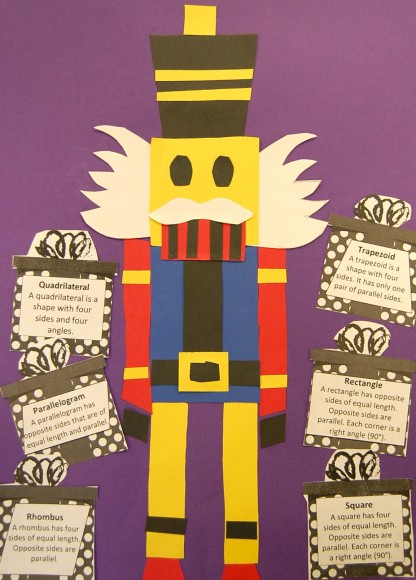I’m joining Erin Cobb over at I’m Lovin’ Lit for her fun Thursday Throw Down Linky Party!
As an art teacher I know it’s a little bit “unfair” to compare how I use interactive learning to how a classroom teacher does. So I wanted to be “fair” and share how I integrate core subjects into my art lessons. I work at a title one school and the majority of my students speak English as their second language. Whenever I can help them with their math, reading, writing, science, social studies , etc. etc. I do. There are certainly times we do art for just the sake of art, materials investigation and discovery learning, but most of the time I’m trying to integrate my art lessons with the common core subjects to help my students as much as possible and to provide them with an alternate (fun) way of learning. This is also what I try to create for my online teaching store over at Teachers Pay Teachers. I create and share art integration lessons that save the teacher time and make learning fun for kids. In this post I will be highlighing one of my favorite lessons: Quadrilateral robots (grade 3-5). Next month I will share my math fact group posters (grades 3-5) and my Salvador Dali telling time lesson (grades 1-2).
Quadrilateral ![robots for blog post.005-001]()
Common Core Standards
3rd grade: CCSS.Math.Content.3.G.A.1 Understand that shapes in different categories (e.g., rhombuses, rectangles, and others) may share attributes (e.g., having four sides), and that the shared attributes can define a larger category (e.g., quadrilaterals). Recognize rhombuses, rectangles, and squares as examples of quadrilaterals, and draw examples of quadrilaterals that do not belong to any of these subcategories.
4th grade: CCSS.Math.Content.4.G.A.2 Classify two-dimensional figures based on the presence or absence of parallel or perpendicular lines, or the presence or absence of angles of a specified size. Recognize right triangles as a category, and identify right triangles.
5th grade: CCSS.Math.Content.5.G.B.3 Understand that attributes belonging to a category of two-dimensional figures also belong to all subcategories of that category. For example, all rectangles have four right angles and squares are rectangles, so all squares have four right angles.
5th grade: CCSS.Math.Content.5.G.B.4 Classify two-dimensional figures in a hierarchy based on properties.

Math + Art = FUN! Learn about quadrilaterals while designing and constructing a robot. Show students an example of a robot made up of only quadrilateral shapes. Instruct students that they are to create their robot using ONLY the quadrilateral shapes of squares, rectangles, rhombuses, parallelograms, trapezoids and kites. Encourage students to use their imaginations to create a robot of their own design!

STEPS:
Step #1: Teach students what quadrilaterals are. Click here for a free handout.
Step #2: Draw each quadrilateral shape on the board; square, rectangle, trapezoid, rhombus, parallelogram and kite. Instruct students that they will be making a robot using only these shapes. Encourage them to use their imaginations to create their robots.
Step #3: Give students a 12” x 18” sheet of black paper and a variety of colored construction paper. You can choose a color scheme or just let the kids pick!
Step #4: Give students scissors and have them cut out quadrilateral shapes for the body, head, arms, & legs using the primary colored construction paper (students should not glue yet). Some students like to use a pencil at this step and first draw the shape before they cut it out. Other students like to cut without drawing first. Let the artists decide how they would like to solve this. Encourage student to describe the quadrilateral shapes they are making to one another

Step #5: Have students cut out smaller details for the robot, such as the eyes, mouth, hands, feet and other smaller shapes. Remind students that they are using only quadrilateral shapes.
Step #6: Once students have cut out and roughly assembled all of the pieces on the black paper give them glue sticks so they can begin gluing down each piece.
Voila! Your finished work will be a fun, creative and colorful quadrilateral robot. Not only will students have a lot of fun dreaming up their Robot but they will also become familiar with all types of Quadrilaterals in a very fun and easy way!
Here are some of the finished Robots.


This lesson was so fun I even created a holiday version: Quadrilateral Nutcrackers


On top of the art project I decided it would be fun to see how deep the learning of quadrilaterals actually went. So I created a game called “Robot Road” and students use their knowledge of quadrilaterals and all the subsets to answer higher level thinking questions. Students get to use a paper robot to move along the “road” and discover what quadrilateral is a subset of another. If you are interested in the game and worksheets click here.

 .
.
I have included one FREE sample of the posters that are in my unit. Please click here to download the Kite Poster.

I thank you for reading my post and I hope you see how fun art integration can be! Next month I will be writing about my math fact collaborative group posters – I have them for addition, subtraction, multiplication and division and for all different times of the year. I hope you all have a great year!
See you soon !
Jenny K.



